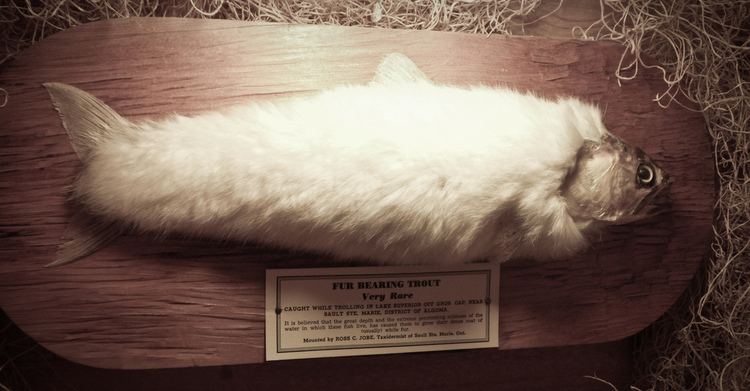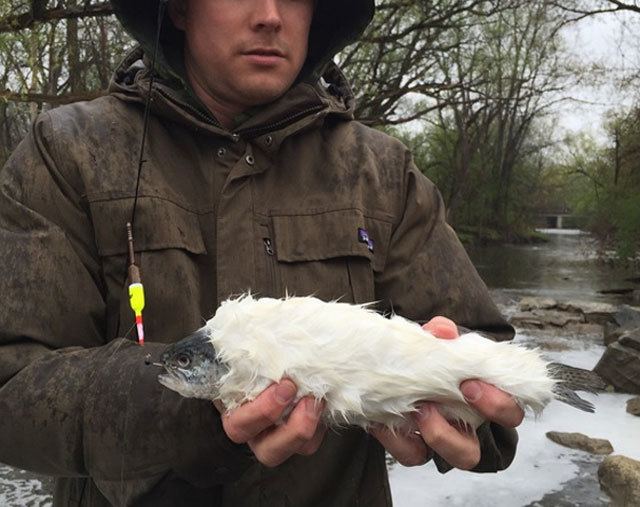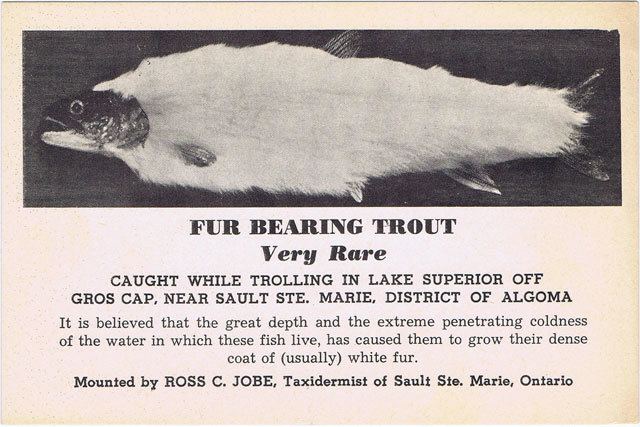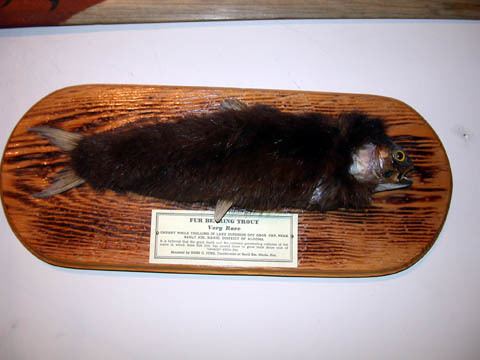 | ||
Similar Axehandle hound, Hoop snake, Splintercat, Ball‑tailed cat, Skvader | ||
Fur bearing trout real or fake
The fur-bearing trout (or furry trout) is a fictional creature purportedly found in North America and Iceland. According to tales, the trout has created a thick coat of fur to maintain its body heat. Tales of furry fish date to the 17th-century and later the "shaggy trout" of Iceland. The earliest known American publication dates from a 1929 Montana Wildlife magazine article by J.H. Hicken. A taxidermy furry trout produced by Ross C. Jobe is a specimen at the Royal Museum of Scotland; it is a trout with white rabbit fur "ingeniously" attached.
Contents
- Fur bearing trout real or fake
- Fur bearing trout
- Commonalities
- Icelandic Lodsilungur
- United States furry trout
- Canada
- References

There are no real examples of any fur-bearing trout species, but two examples of hair-like growths on fish are known. The "cotton mold", Saprolegnia, can infect fish, which can result in the appearance of fish covered in the white "fur". A real fish, Mirapinna esau, also known as the "Hairy Fish", has hair-like outgrowths and wings.

Fur bearing trout
Commonalities

Fur-bearing trout are fictional creatures that are purportedly found in Arkansas, northern North America, and Iceland. The basic claim (or tall tale) is that the waters of lakes and rivers in the area are so cold that they evolved a thick coat of fur to maintain their body heat. Another theory says that it is due to four jugs - or two bottles - of hair tonic being spilled into the Arkansas River.

The origins vary, but one of the earlier claims date to a 17th-century Scottish immigrant's letter to his relatives referring to "furried animals and fish" being plentiful in the New World. It was followed by a request to procure a specimen of these "furried fish" and one was sent one home. A publication in 1900 recounts the Icelandic Lodsilungur, another haired trout, as being a common folklore. The earliest known American publication dates from a 1929 Montana Wildlife magazine article by J.H. Hicken.

The "cotton mold" Saprolegnia will sometimes infect fish, causing tufts of fur-like growth to appear on the body. A heavy infection will result in the death of the fish, and as the fungus continues to grow afterwards, dead fish that are largely covered in the white "fur" can occasionally be found washed ashore. A real fish, Mirapinna esau known as the "Hairy Fish", has hair-like outgrowths and wings. It was discovered in the Azores in 1956.
Icelandic Lodsilungur
According to Icelandic legend, the Lodsilungur is a furry trout that is the creation of demons and giants. The Lodsilungur are described as inedible fish that overwhelm rivers and are a form of punishment for human wickedness. In 1900, The Scottish Review featured an account of the Lodsilungur as a poisonous "Shaggy trout" of northern Iceland. In 1854, a shaggy trout was "cast on shore at Svina-vatn" and featured in an 1855 illustration in Nordri, a newspaper. It was described as having a reddish hair on its lower jaw and neck, sides and fins, but the writer of the Nordri article did not specifically identify it by name. Sjón, a popular Icelandic writer, became obsessed with the folk tale when he was nine. Sjón recounted that if a man were to eat the furry trout he would become pregnant and that his scrotum would have to be cut open to deliver the baby. Sjón noted that the story "might explain why I was later propelled towards surrealism."
United States furry trout
An account of a furry trout appeared in 1929 in Montana Wildlife magazine and was first noted by J.H. Hicken. Hicken's account states that when the fish is caught "the change of temperature from this water to atmosphere is so great that the fish explodes upon being taken from the water, and fur and skin come off in one perfect piece, making it available for commercial purposes, and leaving the body of the fish for refrigerator purposes or eating, as desired."
Another fur-bearing trout story originated with Wilbur Foshay, secretary of the Chamber of Commerce. Foshay promoted the story so convincingly that it was picked up by the Salida Record newspaper. According to its Foshay, the trout grew fur due to the cold temperatures of the Arkansas River and shed the fur as the water temperatures warmed in the summer. In November 1938, a story in the Puebloan Cheiftan recounted the hairy trout history and stated that "[o]ld-timers living along the Arkansas River near Salida have told tales for many years of the fur-bearing trout indigenous to the waters of the Arkansas near there." In 2014, Mysteries at the Museum visited the Salida Museum and is expected to be part of a segment in late 2014.
A tall tale was recounted by S.E. Schlosser, it states that hairy trout were the result of two bottles or four jugs of spilled hair tonic. To catch hairy trout, fisherman would act as barbers and lure fish from the waters with the offer of a free trim or shave. An intentionally fantastical story in Maine and claimed hairy trout were under catch and release policy that was enforced by wardens' carrying Brannock Devices. If a fish was caught, the warden would measure it against the fisher's foot. If the fish's length matched the fisher's foot size, the fish could be eaten and the outards made into furry slippers.
Canada
The Canadian fur-bearing trout is another example of the furry trout hoax. According to the story, a trout with white fur was caught in Lake Superior off Gros Cap in Sault Ste. Marie, Ontario, Algoma District, Canada, and its taxidermist was Ross C. Jobe of Sault Ste. Marie. The purchaser of the fish learned of the hoax after presenting it to the Royal Museum of Scotland. The white fur of a rabbit was described as being "ingeniously" attached to the fish. A fictional description of the Canadian "Hairy" Trout was published by Takeshi Yamada.
